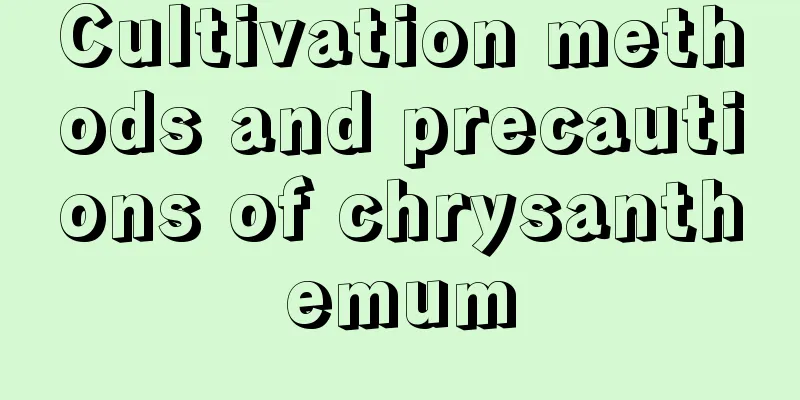Cultivation methods and precautions of chrysanthemum

1. Maintenance methods1. Substrate selection: Chrysanthemum chrysanthemum prefers loose and well-ventilated substrates. It can be made of garden soil, rotted soil, and mud pond in a certain proportion, and then mixed with organic fertilizer and a small amount of water. 2. Temperature management: The most suitable temperature is 17℃--20℃. It is best to use plastic film for insulation when winter turns to spring. Remove the film when the weather gets warmer. Increase ventilation around the plant when the temperature is above 25℃. 3. Water management: Water the seedlings after they emerge from the soil. Just keep the soil moist and do not allow excess water to accumulate in the soil. 4. Nutrient management: Use urea solution once every month and an appropriate amount of nitrogen, phosphorus and potassium fertilizers every month. It should be noted that you cannot use uncomposted fertilizer, as it will burn its roots. 2. Breeding techniques1. Sowing: Choose healthier seeds with full grains, and then dry the seeds for 2 hours before germination. Water it every day and it will germinate in about 3 to 5 days. You can sow in spring in April or May, or in autumn in August or September. 2. Overwintering: When raising plants in winter, they need to be kept warm. You can use plastic film for protection and then remove the film when the weather gets warmer. In winter, you cannot let it grow in windy places and you must pay attention to wind protection. 3. Problem diagnosis and treatment1. Root rot: Root rot of Chinese chrysanthemum is usually caused by boron deficiency in the soil. Add boron fertilizer outside the roots. It may also be that you are watering too much and you should reduce the amount of watering appropriately. 2. Cabbage borer: These insects will harm its growth. If the damage is minor, it will affect the growth of the seedlings. If the damage is severe, it will cause the leaves and roots to rot and die. If there is a silk screen, use 4000 times diluted 5% Yitaibao emulsion to spray two or three times, and be sure to spray the medicine in the heart of the vegetable. IV. Other issues1. Can it be planted in the ground: It can be planted in the ground or in a greenhouse. The planting range is large and there are no obvious regional and growing condition requirements. 2. Is it toxic?: It is not toxic, has certain benefits to the human body, can be eaten, and is a kind of vegetable. |
<<: The cultivation methods and precautions of Kaempferia galanga
>>: Cultivation methods and precautions of cliff chrysanthemum
Recommend
How to grow Ji Qiuli
Method of blooming pot Lighting Management When t...
Why is the Areca palm not suitable for home use?
1. Reasons why Areca palm is not suitable for hom...
The best time to transplant ground-planted roses
Rose, also known as rose and rose , is a highly o...
How much is the yield of Qumacai per mu? The yield and profit per mu of planting
Yield per mu of radish The mycelium wilfordii, al...
What to do if the tulip bulb rots?
How to solve the rot of tulip hydroponic bulbs Me...
Clivia miniata, money tree...just throw it into the water, and it will suddenly grow like crazy!
Throw the Clivia into the water and it will grow ...
Can litchi be grown in the north? How to grow litchi in greenhouses in the north
Planting lychees in the north Lychees can be grow...
How to sow the chrysanthemum
Specific sowing method Sowing Seeds If you grow c...
When does hibiscus bloom?
When does hibiscus bloom? The flowering time of h...
What to do if gardenia has scale insects
1. Introduction to pests It mainly harms branches...
How does Zixuanyue spend the winter?
temperature The best growing conditions for Purpl...
Can fish bones be used as fertilizer?
Fish bones as fertilizer Fish bones can be used a...
Lily Bamboo Cultivation Methods and Precautions
Lily is a unique plant with leaves that are green...
What should I do if the pennywort grows too long?
Causes of Lean Growth When it comes to leggy grow...
How to propagate bamboo palm
How to propagate bamboo palm The propagation of b...









